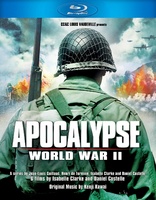Apocalypse: World War II Blu-ray Movie
HomeApocalypse: World War II Blu-ray Movie 
Entertainment One | 2010 | 312 min | Not rated | Mar 29, 2011Movie rating
7.7 | / 10 |
Blu-ray rating
| Users | 0.0 | |
| Reviewer | 3.5 | |
| Overall | 3.5 |
Overview
Apocalypse: World War II (2010)
This captivating documentary series takes an in-depth look at the Second World War through the eyes of those who lived through it: the soldiers, the victims, and the political and military leaders. Using archival footage – most of it previously unseen and now colorized – this series provides an intimate and breath-taking examination of history’s most devastating war.
Narrator: Mathieu Kassovitz, Martin Sheen, Jonathan BoothDirector: Isabelle Clarke, Daniel Costelle
| War | Uncertain |
| History | Uncertain |
| Documentary | Uncertain |
| Foreign | Uncertain |
Specifications
Video
Video codec: MPEG-4 AVC
Video resolution: 1080p
Aspect ratio: 1.78:1
Original aspect ratio: 1.78:1
Audio
English: Dolby Digital 5.1
Subtitles
English
Discs
50GB Blu-ray Disc
Two-disc set (2 BDs)
Playback
Region A (B, C untested)
Review
Rating summary
| Movie | 3.5 | |
| Video | 3.5 | |
| Audio | 4.0 | |
| Extras | 3.0 | |
| Overall | 3.5 |
Apocalypse: World War II Blu-ray Movie Review
We bring you the following special program, in living semi-color.
Reviewed by Jeffrey Kauffman March 17, 2011It’s always interesting to see what raises various people’s ire when new Blu-rays hit the market. Some are undone by the lack of lossless audio, others go bananas about releases not being in the original aspect ratios. Two of my most controversial releases last year were Grindhouse and The World at War, certainly two of the most disparate titles imaginable. Grindhouse was roundly criticized for offering no lossless soundtrack, and The World at War was pilloried for having been released on Blu-ray in 1.78:1, despite the original television presentation having been in the “old” standard ratio of 1.33:1. I took some personal brickbats as I felt neither issue was an ultimate deal breaker in terms of either product. Yes, Grindhouse would have been better with a lossless track, and while it’s arguable that not much visual data was lost when the producers of The World at War reframed the new hi-def release virtually frame by frame, it would have been nice in the best of all possible worlds to have had the original presentation memorialized on Blu-ray. But what is one to make of this new Blu-ray of a French television series which has colorized (of all things) old archival footage while revisiting much the same territory that The World at War seemingly exhaustively trod over a generation ago? This Franco-centric approach to the 20th century’s most epochal battle is certainly well produced and interesting, but what exactly did the colorization bring to the project, especially when that seems to be one of the major marketing calling cards this release is touting? That will be up to the individual consumer to decide, but it’s hard to separate the sometimes bizarre looking images from the otherwise pretty solid approach to recounting the highlights of World War II.
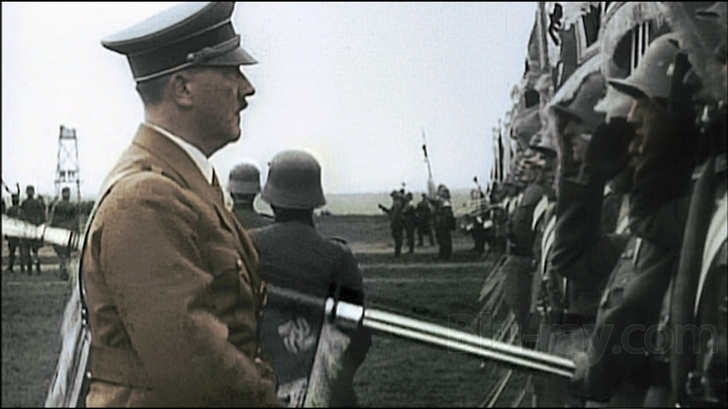
Apocalypse: World War II, while broadcast stateside on The Smithsonian Channel, is a French production and it features copious footage culled from wartime documentaries made by the French Army Film Unit (now known as ECPAD). There are also a wealth of other sources utilized, including home movies and newsreel footage, most of which is being promoted as never having been seen before. Some of this footage is frightening and visceral, and it includes several shots (no pun intended) of both soldiers and civilians getting mowed down by gunfire. With the lurid colorization applied, there are also glistening examples of bloody corpses strewn throughout this sometimes gruesome footage.
There are six episodes of Apocalypse: World War II, and they do a generally good job of giving a decent overview of the chronology and motivations of the major players. The series starts in the ruins of Berlin as the Allies close in in mid-1945, and then moves backward to give some background on Germany and the psychological depths it suffered as a result of its humiliating defeat in World War I, and then the added embarrassment of the overly harsh Treaty of Versailles. Hitler’s own personal vendetta against France is explored and there’s also good coverage given to the conservative, pacifist and neutral elements that populated the governments of England and the United States at the time. The series, perhaps because of its French origin, seems perhaps bit embarrassed itself to go into a lot of detail about the Maginot Line, and France’s naïvete about how “impassable” the Ardennes Forest really was.
Nonetheless, the second episode actually starts with some charming footage of schoolchildren entering school in a little village next to the Ardennes, footage which comes to a chilling close with shots of an empty and abandoned, shattered schoolhouse after the Germans had blasted their way through the supposedly impassable forest and started to make their way toward the heart of France. Hitler bet everything on a giant hoax, a hoax which hinged upon one of World War I’s iconic gambits, utilizing Belgium as a fulcrum to gain entry into France. Much like the Allies would mislead Hitler himself years later with the onslaught at Normandy, Hitler led the French to believe Belgium was the real target, even while his forces were approaching the Ardennes. France miscalculated greatly, sending its most experienced troops to defend the Belgian border, and Hitler had no problems other than his own self-created traffic jams in pushing through into France.
The next two episodes are anchored fairly completely in 1941, and include such now legendary battles as Hitler’s attack on Russia, Rommel’s African campaign, and of course Pearl Harbor. There’s some very interesting material here, including an analysis of Hitler’s frustration that Roosevelt refused to declare war on Germany even after the Japanese had attacked the Hawaii port. Hitler was then in the depths of his disastrous Eastern campaign and felt if he came out on the side of the Japanese, the Japanese would reciprocate and help him annihilate the Russians. As with so many mid- and late-War calculations, Hitler was decidedly wrong.
For film buffs, there’s a brief segment on legendary director John Ford and his filming of the battle of Midway, including a few snippets from his documentary. There’s a recounting of the explosion which cost Ford one of his eye (hence his iconic eyepatch), as well as his classic quote once he came to, “Wow, that was a close one!” But Ford also was reassured by the calm bravery of the very young men around him that day and came to the conclusion that based on their demeanor under fire, the war was more or less won for the Allies, it was only a matter of time.
The final two episodes recount the slow, steady turning of the tide as Germany faces defeat after defeat and the Allies slowly advance on their prey, showing little if any mercy. We get some insight into the “grunt” mentality, as we hear quotes from some rank and file German soldiers who had begun to question the Fuhrer’s health and mental stability. But even on the Allied side, the ongoing stresses of the war had weighed incredibly heavily on Roosevelt, and there’s some touching footage of one of his last public appearances in Yalta, where he was incredibly gaunt, sucking at one cigarette after another as if to try to calm his raging nerves.
As fine as much of Apocalypse: World War II is, it can’t help but be compared to the 900 pound elephant of all World War II television documentaries, The World at War, and for a lot of viewers it will probably fall at least somewhat short of that vaunted mark. Not only was The World at War considerably longer and more detailed, it also benefited immensely from the first-person involvement of scores of people who were actually there for some of the decisive moments of the war. Here, we get one solitary narrator who occasionally voices other characters, but that approach simply lacks the personal connection that The World at War offered.
Perhaps more troubling, at least to persnickety types (and you know who you are), is the colorization factor. While the technology has certainly improved since the days Ted Turner hid out in an undisclosed location after he decided to “tart up” vintage black and white films in his Warner and MGM libraries for broadcast purposes, it is still often woefully inadequate and just looks ridiculous a lot of the time. What is incredibly noticeable here is how only certain elements in a lot of shots have been colorized, while the surrounding scenery and background remains resolutely black and white. Even stranger is the occasional decision not to colorize, as in some heart-rending footage of the Warsaw ghetto and its inhabitants. Apocalypse: World War II would have done much better to have simply left this footage alone, at least in terms of the colorizing process.
Still, it’s interesting to see a French take on a lot of this information. Especially fascinating are heretofore unfamiliar aspects of familiar battles, as with D-Day, where this series focuses more on the Free French troops who had escaped to England and now returned to help reclaim their country from the Nazi occupiers. That sort of information is where Apocalypse: World War II really shines, and it doesn’t need the fake looking colorization to help it succeed when it approaches its subject from such a personal viewpoint.
Apocalypse: World War II Blu-ray Movie, Video Quality 
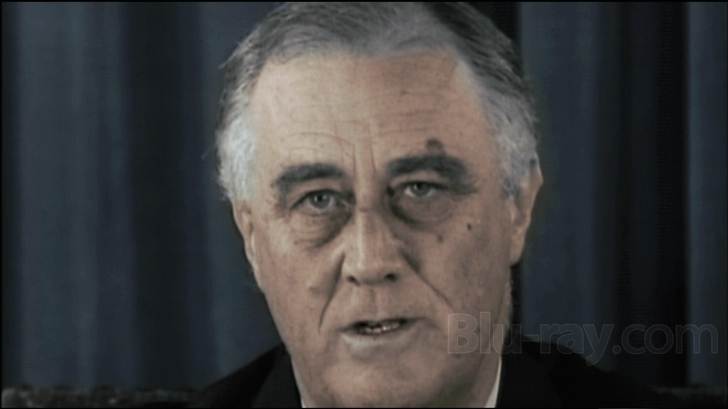
Apocalypse: World War II blasts onto Blu-ray with an AVC encoded 1080i transfer in 1.78:1. It's obviously fairly useless to talk about "lifelike" color or natural saturation when one is dealing with an artifically colorized product like this. As with most colorized footage, everything is washed out, pale looking and often unreal in overall ambience. What makes the colorizing even harder to take is the actual color footage included (as with the home movies of Hitler at Berchtesgaden), which make the colorized segments literally pale by comparison. The good news is that a lot of this footage has been rather meticulously restored and we therefore are granted a well above average sharpness and clarity in a lot of the older sequences. As with any documentary, footage has been sourced from a huge variety of elements, and some of the smaller millimeter formats are incredibly grainy and soft, something the colorizing only makes worse. There's also noticeable edge enhancement an haloing on several shots. Again as might be expected, some of the source elements are badly damaged, to the point where even restoration can't completely ameliorate specks, dirt and other debris.
Apocalypse: World War II Blu-ray Movie, Audio Quality 
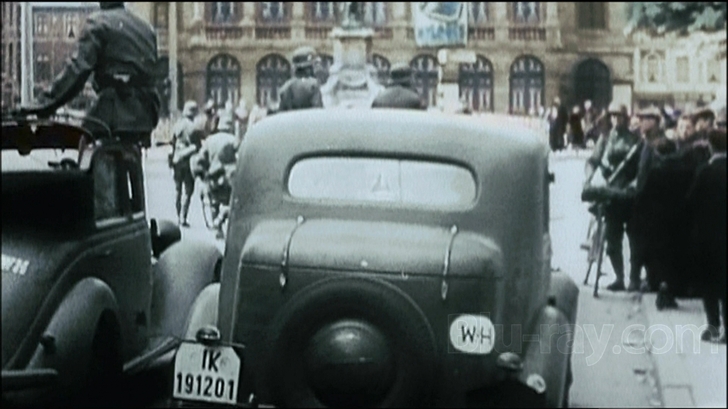
Though the Blu-ray insert, slipcover and accompanying press sheet all proclaim this release has a lossless DTS-HD Master Audio 5.1 mix, the only audio option on the review copy sent to me was a standard Dolby Digital 5.1 mix. Though it's lossy, this is a well defined and actually very carefully constructed mix which includes a wealth of ambient effects which spill into the surrounds with pleasing frequency. The sound effects include the expected explosions and gunfire but also include a number of quieter moments, things as subtle as heels clicking down a hallway or the rustling of papers. The narration is front and center and always easy to hear, and Kenji Kawai has provided an appealing underscore which owes quite a bit to Carl Davis' wonderful work on The World at War.
Apocalypse: World War II Blu-ray Movie, Special Features and Extras 
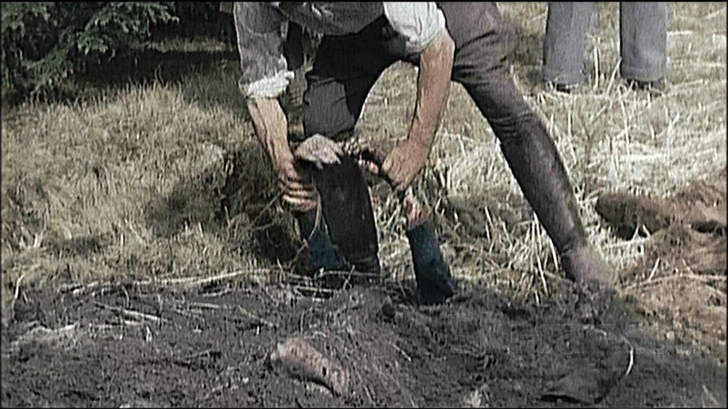
- Original ECPAD Documentaries (SD; 58:53 cumulative). Spread over both discs of this set are an interesting assemblage of original wartime documentaries made by the French Army Film Unit, which are heavily excerpted for the series itself. These cover major battles and give a really interesting insight into the French take on the war. In French with forced English subtitles.
- Making of Featurette (SD; 49:59). It's not exactly propitious when a documentary starts out with one of the crew exclaiming "I'm sick of it. I've been working on this project for six months." Adding insult to injury, collaborators (and couple) Isabelle Clarke and Daniel Costelle then start giving on-camera directions to the documentary filmmaker with regard to how to frame their interview. Ah, those crazy French! This featurette does give some interesting background into the two and a half year production process, and it includes a wealth of behind the scenes footage, if a bit too much is devoted to Clarke and Costelle (probably at their own direction).
Apocalypse: World War II Blu-ray Movie, Overall Score and Recommendation 

Apocalypse: World War II is best when it shows the French viewpoint, and that's this documentary's real calling card. The colorizing is needless and often actually detracts from the visual presentation. The documentary is well-written and provides a wealth of fascinating source footage to augment the narration. While this is certainly no World at War, it's still often compelling and comes Recommended.
Similar titles
Similar titles you might also like

Apocalypse: Hitler
Apocalypse: The Rise of Hitler
2011

The World at War
1973

They Shall Not Grow Old
2018

The World Wars
2014

WWII in HD
World War II in HD
2009

The Vietnam War
2017

WWII From Space
2012

Restrepo
2010

Victory at Sea
Deluxe Edition
1952-1953

Gettysburg
2011

The Longest Day
1962

Ken Burns: The Civil War
1990

Vietnam in HD
2011

The 12th Man
Den 12. mann
2017

The War
2007

Land of Mine
Under Sandet
2015

Shoah
1985

Journey's End
2017

Korengal
2014

D-Day: Normandy 1944 4K
75th Anniversary Edition
2014
